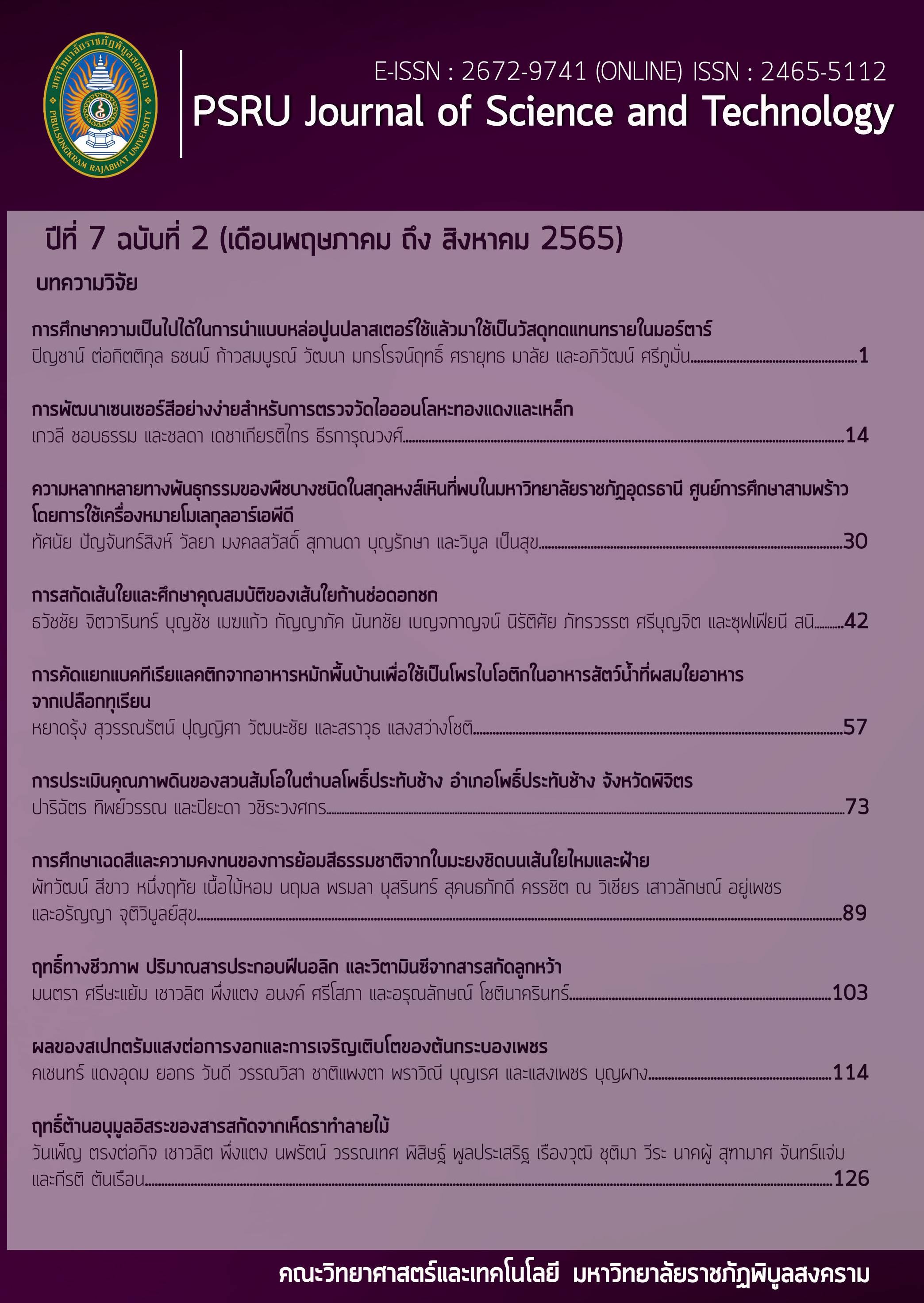SCREENING LACTIC ACID BACTERIA FROM LOCAL FERMENTED FOOD FOR USING AS PROBIOTIC IN AQUATIC ANIMAL FEED MIXED WITH DIETARY FIBER FROM DURIAN RIND
Keywords:
Lactic acid bacteria, Fermented food, Dietary fiber, Durian rind, Thai CarpAbstract
This research aimed to use dietary fiber (DF) from durian rind as a prebiotic with probiotic bacteria from fermented food in the aquatic feed for feeding the Thai carp.
The experiments comprised of screening the lactic acid bacteria (LAB) from fermented food and preparation of aquatic animal feed by using DF from durian rind as a prebiotic with the isolated probiotic bacteria for feeding the Thai carp. The results of screening the LAB from 30 fermented food samples found that 35 isolates of LAB were isolated and all isolate were able to grow in anaerobic condition. There were 31 LAB isolates could grow in aerobic and anaerobic conditions. For the probiotic properties, there were 6 LAB isolates could tolerate acid and bile salt conditions. The LAB with the best probiotic property and growth was selected to use in the next experiment. The preparation diet was started by preparing the DF from durian rind, mixed the DF in Thai carp diet at the percentage of 0, 10, 20, 30, and 40 mixed the obtained diet with probiotic cells and used diet to feed fishes. The results found that
the utilization of DF from durian rind mixed in Thai carp diet at different levels led to
the growth of trial fish included weight gain, average daily gain (ADG), specific growth rate (SGR), feed conversion ratio and survival rate were not significant difference from the control. From the results indicated that the aquatic animal prepared from DF of durian rind could be used with isolated probiotic bacteria from fermented food for feeding Thai carp and can be a guideline to add value of durian rind.
References
คณิสร ล้อมเมตตา, สิทธิพัฒน์ แผ้วฉ่ำ, สนธยา กูลกัลยา, และอุมารินทร์ มัจฉาเกื้อ. (2556). การใช้เปลือกทุเรียนและเมล็ดทุเรียนบดแห้งทดแทนปลายข้าวในสูตรอาหารเลี้ยงปลาตะเพียนขาว. ใน การประชุมนำเสนอผลงานวิจัยระดับชาติ ครั้งที่ 6 (น. 474-484) ภูเก็ต: มหาวิทยาลัยราชภัฏภูเก็ต.
คณิสร ล้อมเมตตา, สิทธิพัฒน์ แผ้วฉ่ำ, สนธยา กูลกัลยา, และอุมารินทร์ มัจฉาเกื้อ. (2559). การใช้เปลือกทุเรียนและเมล็ดทุเรียนบดแห้งทดแทนปลายข้าวในสูตรอาหารเลี้ยงปลาไน. วารสารวิจัยรำไพพรรณี, 10(2), 109-117.
จีรนุช วันแสนซื่อ, สิริรัตน์ แสงอ่อน, และสุรีย์พร เอี่ยมศรี. (2560). การคัดเลือกแบคทีเรียโพรไบโอติกจากฟาร์มและโรงฆ่าสุกรที่มีประสิทธิภาพยับยั้งแบคทีเรียดื้อยาปฏิชีวนะ. ใน การประชุมวิชาการระดับชาติ วิทยาศาสตร์และเทคโนโลยีระหว่างสถาบัน ครั้งที่ 5 (น. 729-737). กรุงเทพฯ: โรงแรมมิราเคิล แกรนด์ คอนเวนชั่น.
ชาญวิทย์ สุวรรณ์, และชนกันต์ จิตมนัส. (2563). การใช้จุลินทรีย์จีไบโอติกเสริมอาหารปลานิล เพื่อเร่งการเจริญเติบโตและเสริมภูมิคุ้มกัน. วารสารเกษตรพระวรุณ, 17(1), 63-74.
นัยนา เสนาศรี. (2558). ผลของการใช้แบคทีเรีย Bacillus spp. เป็นโปรไบโอติกผสมอาหารในการเลี้ยงปลานิล, วารสารวิจัย, 8(2), 61 – 66.
ผุสดี ตังวัชรินทร์, จิรโรจน์ นิธิสันถวะคุปต์, และกานต์ สุขสุแพทย์. (2559). การคัดแยกและการคัดเลือกแบคทีเรียแลคติกที่มีสมบัติความเป็นโปรไบโอติกเบื้องต้นจากผลิตภัณฑ์เนื้อหมัก. วารสารเกษตรพระจอมเกล้า, 34(2), 67-76.
พงศธร ล้อสุวรรณ, จิตศิริ ราชตนะพันธุ์, และศศิธร จันทนวรางกูร. (2551). สารประกอบฟีนอลิกทั้งหมด สมบัติการต้านอนุมูลอิสระ และการต้านจุลินทรีย์ของเปลือกผลไม้. ใน การประชุมทางวิชาการของมหาวิทยาลัยเกษตรศาสตร์ ครั้งที่ 46 (น. 554-561). กรุงเทพฯ: มหาวิทยาลัยเกษตรศาสตร์.
ไพรัตน์ กอสุธารักษ์. (ม.ป.ป). การประเมินคุณภาพของอาหารสำเร็จรูปสำหรับสัตว์น้ำตามพระราชบัญญัติควบคุมคุณภาพอาหารสัตว์. สืบค้นเมื่อ 12 ตุลาคม 2563, จากhttps://www4.fisheries.go.th/local/file_document/20170120165958_file.pdf.
ภณิดา เกื้อสุวรรณ, วิลาวัณย์ เจริญจิรตระกูล, และดวงพร คันธโชติ. (2557). การคัดเลือกโปรไบโอติกแบคทีเรียแลกติกเพื่อใช้เป็นกล้าเชื้อในการผลิตผักดอง. ใน การประชุมวิชาการเสนอผลงานวิจัยระดับบัณฑิตศึกษา ครั้งที่ 15 (น. 667-676). ขอนแก่น: มหาวิทยาลัยขอนแก่น.
เวียง เชื้อโพธิหัก. (2545). โภชนศาสตร์สัตว์น้ำและการให้อาหารสัตว์น้ำ. กรุงเทพฯ: สำนักพิมพ์มหาวิทยาลัยเกษตรศาสตร์.
สํานักงานคณะกรรมการอาหารและยา. (2563). ประกาศกระทรวงสาธารณสุข เรื่อง การใช้จุลินทรีย์โพรไบโอติกในอาหาร. สืบค้นเมื่อ 15 ธันวาคม 2563 จาก http://www.ratchakitcha. soc.go.th/DATA/PDF/2554/E/086/21.PDF.
สุรัตน์ วังพิกุล, และปริยาภรณ์ อิศรานุวัฒน์. (2557). การคัดเลือกแลคติกแอสิดแบคทีเรียที่มีศักยภาพเป็นจุลินทรีย์โปรไบโอติกจากอาหารหมักพื้นบ้านไทยประเภทข้าวเพื่อใช้เป็นกล้าเชื้อในอาหารหมัก (รายงานการวิจัย). พระนครศรีอยุธยา: มหาวิทยาลัยเทคโนโลยีราชมงคลสุวรรณภูมิ.
หยาดรุ้ง สุวรรณรัตน์, จิรพร สวัสดิการ, ปารณีย์ สร้อยศรี, และคมสัน มุ่ยสี. (2560). สมบัติทางกายภาพและความสามารถในการเป็นสารต้านอนุมูลอิสระของใยอาหารจากเปลือกทุเรียน. ใน การนำเสนอผลงานวิจัยระดับชาติ เครือข่ายบัณฑิตศึกษา มหาวิทยาลัยราชภัฏภาคเหนือ ครั้งที่ 17 (น. 2279-2287). พิษณุโลก: มหาวิทยาลัยราชภัฏพิบูลสงคราม.
หยาดรุ้ง สุวรรณรัตน์, และจิรพร สวัสดิการ. (2561). ปริมาณใยอาหารและคุณสมบัติการต้านแบคทีเรียของใยอาหารจากเปลือกทุเรียนที่ผ่านการทำแห้งแบบลมร้อนและแบบแช่เยือกแข็ง. วารสารวิจัยรำไพพรรณี, 12(1), 178-185.
AACC. (2001). The definition of dietary fiber. CFW AACC Report, 46(3), 112-116.
A.O.A.C. (2000). Official methods of analysis association of official analytical chemists. Washington, DC.
Deyab, M., & Magdy, M. (2003). Replacement of fish meal with a mixture of different plant protein sources in juvenile Nile tilapia, Oreocromis niloticus (L.) diets. Aquaculture Research, 34, 1119-1127.
Fuentes-Alventosa. J.M., Rodriguez-Gutierrez, G., Jaramillo-Carmona, S., & Expejo-Calvo, J.A. (2009). Effect of extraction method on chemical composition and functional characteristics of high dietary fibre powders obtained from asparagus by products. Food Chemistry, 113(2), 665-671.
Hwanhlem, N., Watthanaskphuban, N., Riebroy, S., Benjakul, S., H-Kittikun, A., & Supasil, S. (2010). Probiotic lactic acid bacteria from Kung-Som: Isolation screening, inhibition of pathogenic bacteria. International Journal of Food Science&Technology, 45(3), 594-601.
Kobayashi, T., Kajiwara, M., Wahyuni, M., Hamada-Sato, N., Imada, C., & Watanabe, E. (2004). Effect of culture conditions on lactic acid production of Tetragenococcus species. Journal of Applied Microbiolgy, 96(6), 1215-1221.
Larrauri, J.A., Ruperez, P., & Saura-Calixto, F. (1997). Mango peel fibres with antioxidant activity. Zeitschrift Fur Lebensmittel-Untersuchung Und-Forschung, 205, 39-42.
Lee, J., Kim, C.J., & Kunz, B. (2006). Identification of lactic acid bacteria isolate from kimchi and studies on their suitability for application as starter culture in the production of fermented sausages. Meat Science, 72, 437-445.
Rodriguez, R., Jimenez, A., Fernandez-Bolanos, J., Guillen, R., & Heredia, A. (2006). Dietary fibre from vegetable products as source of functional Ingredients. Trends in Food Science and Technology, 17, 3-15.
Rumsey, G., Hughes, S., & Winfree, R. (1993). Chemical and nutritional evaluation of soya protein preparations as primary nitrogen sources for rainbow trout (Oncorhynchus mykiss). Animal Feed Science and Technology, 40, 135-151.
Soria, M.C., & Audisio, M.C. (2014). Inhibition of Bacillus cereus strains by antimicrobial metabolites from Lactobacillus johnsonii CRL1647 and Enterococcus faecium SM21. Probiotic and Antimicrobial Proteins, 6(3-4), 208-216.
Villamil, L., Figueras, A., Planas, M., & Novoa, B. (2003). Control of Vibrio alginolyticus in artemia cuture by treatment with bacterial probiotic. Aquaculture, 219, 43-56.
Wood, B.J.B, & Hopzapfel, W.H. (1995). The genera of lactic acid bacteria. London Chapman & Hall.
Zannini, E. Water, D.M., Coffey, A., & Arendt, E.K. (2016). Production, properties and industrial food application of lactic acid bacteria-derived exopolysaccharides. Applied Microbiology and Biotechnology, 100(3), 1121-1135.
Downloads
Published
How to Cite
Issue
Section
License
Copyright (c) 2022 PSRU Journal of Science and Technology

This work is licensed under a Creative Commons Attribution-NonCommercial-NoDerivatives 4.0 International License.
กองบรรณาธิการขอสงวนสิทธิ์ในการปรับปรุงแก้ไขตัวอักษรและคำสะกดต่างๆ ที่ไม่ถูกต้อง และต้นฉบับที่ได้รับการตีพิมพ์ในวารสาร PSRU Journal of Science and Technology ถือเป็นกรรมสิทธิ์ของคณะวิทยาศาสตร์และเทคโนโลยี มหาวิทยาลัยราชภัฏพิบูลสงคราม และ
ผลการพิจารณาคัดเลือกบทความตีพิมพ์ในวารสารให้ถือมติของกองบรรณาธิการเป็นที่สิ้นสุด







